商务英语阅读(下册)(第二版) unit 6 中国物流业发展所面临的挑战和机遇
- 格式:ppt
- 大小:352.50 KB
- 文档页数:74
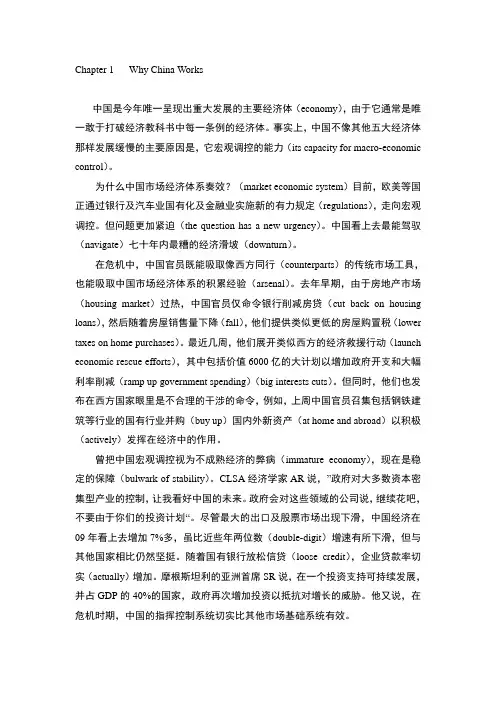
Chapter 1 Why China Works中国是今年唯一呈现出重大发展的主要经济体(economy),由于它通常是唯一敢于打破经济教科书中每一条例的经济体。
事实上,中国不像其他五大经济体那样发展缓慢的主要原因是,它宏观调控的能力(its capacity for macro-economic control)。
为什么中国市场经济体系奏效?(market economic system)目前,欧美等国正通过银行及汽车业国有化及金融业实施新的有力规定(regulations),走向宏观调控。
但问题更加紧迫(the question has a new urgency)。
中国看上去最能驾驭(navigate)七十年内最糟的经济滑坡(downturn)。
在危机中,中国官员既能吸取像西方同行(counterparts)的传统市场工具,也能吸取中国市场经济体系的积累经验(arsenal)。
去年早期,由于房地产市场(housing market)过热,中国官员仅命令银行削减房贷(cut back on housing loans),然后随着房屋销售量下降(fall),他们提供类似更低的房屋购置税(lower taxes on home purchases)。
最近几周,他们展开类似西方的经济救援行动(launch economic rescue efforts),其中包括价值6000亿的大计划以增加政府开支和大幅利率削减(ramp up government spending)(big interests cuts)。
但同时,他们也发布在西方国家眼里是不合理的干涉的命令,例如,上周中国官员召集包括钢铁建筑等行业的国有行业并购(buy up)国内外新资产(at home and abroad)以积极(actively)发挥在经济中的作用。
曾把中国宏观调控视为不成熟经济的弊病(immature economy),现在是稳定的保障(bulwark of stability)。

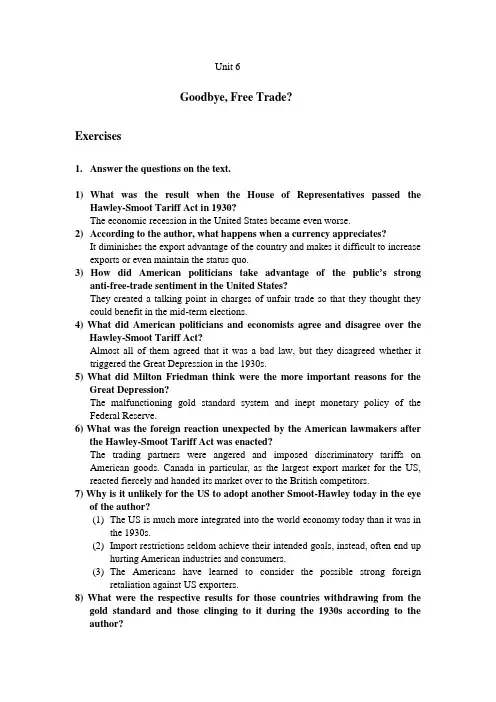
Unit 6Goodbye, Free Trade?Exercises1.Answer the questions on the text.1) What was the result when the House of Representatives passed theHawley-Smoot Tariff Act in 1930?The economic recession in the United States became even worse.2) According to the author, what happens when a currency appreciates?It diminishes the export advantage of the country and makes it difficult to increase exports or even maintain the status quo.3) How did American politicians take advantage of the public’s stronganti-free-trade sentiment in the United States?They created a talking point in charges of unfair trade so that they thought they could benefit in the mid-term elections.4) What did American politicians and economists agree and disagree over theHawley-Smoot Tariff Act?Almost all of them agreed that it was a bad law, but they disagreed whether it triggered the Great Depression in the 1930s.5) What did Milton Friedman think were the more important reasons for theGreat Depression?The malfunctioning gold standard system and inept monetary policy of the Federal Reserve.6) What was the foreign reaction unexpected by the American lawmakers afterthe Hawley-Smoot Tariff Act was enacted?The trading partners were angered and imposed discriminatory tariffs on American goods. Canada in particular, as the largest export market for the US, reacted fiercely and handed its market over to the British competitors.7) Why is it unlikely for the US to adopt another Smoot-Hawley today in the eyeof the author?(1)The US is much more integrated into the world economy today than it was inthe 1930s.(2)Import restrictions seldom achieve their intended goals, instead, often end uphurting American industries and consumers.(3)The Americans have learned to consider the possible strong foreignretaliation against US exporters.8) What were the respective results for those countries withdrawing from thegold standard and those clinging to it during the 1930s according to the author?Those countries going off the gold standard allowed their currencies to depreciate, avoided protectionist trade policies and, instead, used monetary policy to end price deflation and stimulate economic growth.Those countries choosing to stay on pursued protectionist trade policies by imposing high tariffs, import quotas and exchange controls, which did little in boosting their economic growth. Thus they suffered a longer economic depression.9) How does the author justify his support for the policy of "quantitativeeasing"?(1) Historically, the most important tool for resisting protectionist sentiment in the1930s was a monetary policy that would promote economic growth.Today the US is in a similar situation. Taking right monetary policy can alleviate the pressure on Washington to adopt protectionist trade policy and can help to raise output before it leads to a high inflation.(2) He also quotes what Charles Evens said: Additional measures taken by the Fedto stimulate growth should condoned, not condemned.(3) What Mr. Friedman wrote 1997 about Japan: The surest road to a healthyeconomic recovery is to increase the rate of monetary growth, to shift from tight money to easier money.10) What does the author imply about the US Congress?In comparison with the Fed, the US Congress is following a trade protectionist policy in blaming other countries for its unemployment and may cause serious trade retaliations from trading partners.2. Fill in each blank of the following sentences with one of the phrases in the list given below. Make changes when necessary.1)As the financial scandal involves so many people, the probe in to it could dragon for another year.2)In the age of globalization more individuals are forced to integrate intomultinational work teams.3)Many in Europe are now very much worried that it may sink into a Japan-styleeconomic recession.4)But the business leaders yesterday warned against interest rate rises, arguing thatinflation was being driven not by consumer spending, but by rising commodity prices.5)After the call scandal, the American automakers and some politicians there wereso eager to keep their rival Toyota at bay in the auto market.6)Under the current labor law, two categories of employees are exempt fromminimum wage and overtime requirements.7)Though the local partner made a revised offer, the foreigner investor refused andreverted back to the original agreement conditions.8)Last Friday the two parties met for more than five hours only to end up walkingaway from the table once again, reaching no agreement at all.9)When the government supervises banks, it should take into account their payand bonus structures which may often be the source of corruption.10)The customers severely affected in the incident demanded that the company putin place effective measures to avoid occurrence of such things in the future. 11)It’s critical to take hold of any opportunity coming your way because it willnever come back again once lost.12)At times of economic depression, people are more inclined to unethical means intheir business.3. Match the terms in column A with the definitions in column B:A__________________________ B____________________________________ 1)unfair trade A) Restrictions that governments put in placeon the purchase or sale of a foreign or localcurrency, particularly by those in shortageof hard currencies. 62) real estate B) Escalation of protectionism between two ormore countries that impose punitive tariffsand barriers in retaliation for each other. 83) business cycle C) A general decline in prices often caused bya reduction in the money supply or a decreasein spending. 54) trade protectionism D) Unjustifiable and discriminatory policiesand supports by a government to its ownfirms, ranging from export subsidies to anti-competitive practices. 15) price deflation E) Land, buildings, homes or anything fixed,immovable, or permanently attached that canbe traded in the market. 26) exchange control F) The policy of imposing duties or quotas onimports in order to protect home jobs,markets or industries from overseascompetition. 97) competitive currency devaluation G) A company or country with whom you havean ongoing business relationship and engagein importing or exporting activities. 108) trade war H) A predictable long-term pattern ofeconomic activity that an economyexperiences four stages including decline,recession, recovery and boom. 39) import barriers I) The currency devaluation by a governmentto make its goods more competitive in theinternational markets. 710) trading partner L) The economic policy of restrainingbusiness between states through a variety ofgovernment actions to discourage importsand prevent foreign take-over of domesticmarkets and companies. 44. Translate the following passage into Chinese.按官方的说法,中美间过去三天日益严重的贸易纠纷涉及轮胎、鸡肉和汽车,但实际上远远超出此范围。
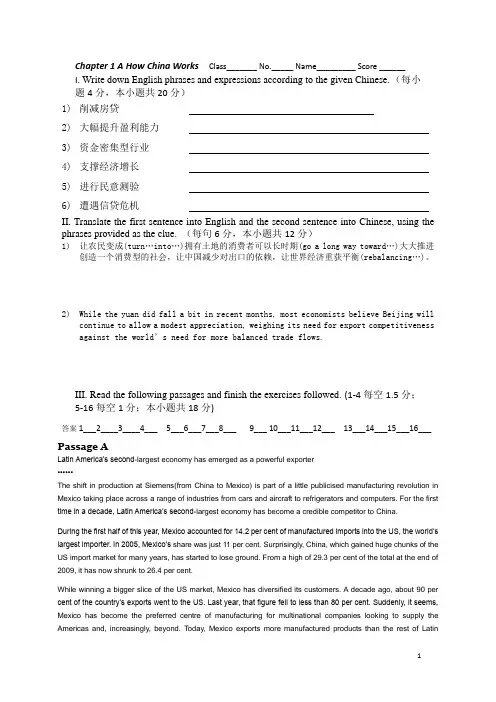
Chapter 1 A How China Works Class_______ No._____ Name_________ Score ______I. Write down English phrases and expressions according to the given Chinese.(每小题4分,本小题共20分)1)削减房贷2)大幅提升盈利能力3)资金密集型行业4)支撑经济增长5)进行民意测验6)遭遇信贷危机II. Translate the first sentence into English and the second sentence into Chinese, using the phrases provided as the clue. (每句6分,本小题共12分)1)让农民变成(turn…into…)拥有土地的消费者可以长时期(go a long way toward…)大大推进创造一个消费型的社会,让中国减少对出口的依赖,让世界经济重获平衡(rebalancing…)。
2)While the yuan did fall a bit in recent months, most economists believe Beijing willcontinue to allow a modest appreciation, weighing its need for export competitiveness against the world’s need for more balanced trade flows.III. Read the following passages and finish the exercises followed. (1-4每空1.5分;5-16每空1分;本小题共18分)答案1___2____3____4___ 5___6___7___8___ 9___ 10___11___12___ 13___14___15___16___Passage ALatin America’s second-largest economy has emerged as a powerful exporter••••••The shift in production at Siemens(from China to Mexico) is part of a little publicised manufacturing revolution in Mexico taking place across a range of industries from cars and aircraft to refrigerators and computers. For the first time in a decade, Latin America’s second-largest economy has become a credible competitor to China.During the first half of this year, Mexico accounted for 14.2 per cent of manufactured imports into the US, the world’s largest importer. In 2005, Mexico’s share was just 11 per cent. Surprisingly, China, which gained huge chunks of the US import market for many years, has started to lose ground. From a high of 29.3 per cent of the total at the end of 2009, it has now shrunk to 26.4 per cent.While winning a bigger slice of the US market, Mexico has diversified its customers. A decade ago, about 90 per cent of the country’s exports went to the US. Last year, that figure fell to less than 80 per cent. Suddenly, it seems, Mexico has become the preferred centre of manufacturing for multinational companies looking to supply the Americas and, increasingly, beyond. Today, Mexico exports more manufactured products than the rest of LatinAmerica put together.The result of this turnround can often seem counter-intuitive. Chrysler, for example, is using Mexico as a base to supply some of its Fiat 500s to the Chinese market. During last year’s inauguration of the US company’s $500m investment in Mexico, Felipe Calderón, the country’s president, told the nation: “I think it is the first time that a Mexican vehicle, at least in recent times, is to be exported to China ... we always thought it was going to be the other way around.”••••••Mexico’s new-found competitiveness has become so clear that Marco Oviedo of Barclays co ncludes: “After lagging Chinese manufacturing exports for a decade, Mexico has taken the lead post-2008-09. We believe this change is likely to be structural and persistent.”Go back to the beginning of the century and none of this seemed possible. Back then, as China burst on to the global stage following its accession to the World Trade Organisation in 2001, Mexico seemed to be in serious trouble.For much of the rest of Latin America, China was a voracious customer of agricultural and mineral commodities. By contrast, Mexico saw China as an unstoppable competitor that produced exactly the same sorts of cheap manufactured goods at a tiny fraction of the cost.Against that backdrop, it is hardly surprising that Mexico was the last WTO member to vote for Chi na’s accession –a vote that it gave only after a long and bitter negotiation.But several important shifts have taken place since then that have improved Mexico’s comparative advantages, giving it a new and dynamic role as a global manufacturer. The first is that Mexico has embraced trade and openness like few other countries in the world.Its free trade agreements with 44 countries – more than twice as many as China and four times more than Brazil –have given companies based in Mexico the ability to source parts and inputs from a wide range of nations, often without paying duty.Partly as a result, the sum of Mexico’s imports and exports as a percentage of its gross domestic product, a strong indicator of openness, rose to 58.6 per cent in 2010. In the case of China, it was 47.9 per cent, and just 18.5 per cent in the case of Brazil. HSBC in Mexico City estimated recently that the figure for Mexico could increase to as much as 69 per cent this year.There is also an increased confidence inspired by agreements, particularly the 1994 North American Free Trade Agreement, which binds Mexico with the US and Canada. “Nafta creates a rule of law, which is not perceived to be a particularly Mexican concept ... it forces you to do what is right, and to do it for eve r, ” says Luis de la Calle, an economist and trade expert who helped negotiate Nafta for Mexico.As if to prove the point, Mr de la Calle devised an unorthodox index based on how many alphabetical letters appear about a given country in the US Trade Repres entative’s annual report on barriers to US exports and investment, divided by US exports to that same country. Last year, from a list of 22 countries, Mexico beat Canada to the top place of best-behaved countries. Pakistan was the worst offender and China was 10th worst.. . .Of course, Mexico is not without its problems. While the country is making strides in its attempts to diversify, it is stillheavily beholden to the ups and downs in the US.But perhaps the most alarming concern of foreign investors and the general population alike is the deterioration in security.The murder rate has almost tripled to about 22 per 100,000 inhabitants from just over eight when Mr Calderón declared an all-out offensive against the country’s drug cartels at the end of 2006. The war, which has claimed at least 55,000 lives over the past six years, has dominated headlines about Mexico as the press reports on a seemingly endless flow of horror stories involving beheadings, kidnappings and massacres.This year, it also prompted the US state department to issue a travel advisory telling US citizens to put off “non-essential travel” to many areas of Mexico, and warning that nearly half of the country’s 31 states are so dangerous that travellers should avoid them if possible.So far, the violence has had little impact on multinationals, which generally operate in safe industrial parks around the country. But there are no guarantees that organised crime will not start to try to extort large foreign companies in the future – and in the same way it has been doing with smaller, domestic companies.Until that happens, foreign companies continue to eye Mexico – in part because China has not turned out to be quite the manufacturing nirvana that it once appeared. While executives long complained of Chinese red tape and the threat to intellectual property there, they were willing to balance those risks against cheap labour and transport.But rising wages and higher fuel prices have made it increasingly expensive to export from China to the US market. This is all to Mexico’s advantage. In 2009, Mexico overtook South Korea and China to became the world’s leading producer of flatscreen television sets. The bulkier the item, the more Mexico makes sense. According to Global Trade Atlas, the country is also the leading manufacturer of two-door refrigerators.Thanks to a 2,000-mile border with the US, and extensive rail and road links, it is not only cheap but fast and easy to ship goods north. Shipments from China to the US typically take between 20 days and two months. From Mexico, they take a week at most and usually just two days.For many industries operating in today’s cost-conscious environment, “Made in Mexico” is becoming a serious consideration in their attempts to shorten supply chains, which potentially allows them to cut costs because quicker delivery times mean that they can minimise the amount of money invested in inventories. As Bruno Ferrari, Mexico’s economy minister, told the Financial Times recently: “The proximity that Mexico offer s industry allows companies to reduce their financing costs.”Rising labour costs in China have presented Mexico with an additional opportunity. According to HSBC, Mexican wages were 391 per cent higher than those of China a decade ago. Today, they are just 29 per cent more. Experts predict that Chinese wages will even overtake those of Mexico within five years.Mr de la Calle argues that demographics are behind this. While China is experiencing a squeeze in its working-age population.By contrast, more tha n half Mexico’s 112m population is under 29, so there will be an abundance of cheap labour until at least 2028. “Right now, you have to look at Mexico and conclude that it has the best demographics in the world,” says Mr de la Calle.At the same time, Mexi co’s plentiful working population is becoming more skilled. According to Unesco, the number of engineers, architects and others in disciplines related to manufacturing graduating from Mexican universities hasrisen from almost 0.4 per 1,000 people in 1999 to more than 0.8 today. To set that in a regional context, the number for the US over the same period has remained roughly flat at 0.6 per 1,000.Skilled workers are providing an increasingly attractive environment for high-tech companies – Mexico has in recent years become a world leader in the production of computers and mobile telephones – as well as for car companies, almost all of which are now using Mexican engineers to design parts.. . .Questions 1)-4) are based on the above passage.1). Do you know who is the largest economy in Latin America?A. USAB. MexicoC. ArgentinaD. Brazil2). What was true at the beginning of the century?A. Mexico joined the WTO in 2001.B. China joined the WTO in 2001.C. China's labour cost was higher than Mexico back then.D. Some things happened then impaired Mexico’s comparative advantages.3). Which of the following is not a consequence of Mexico's "embracing trade and openness like few other countries in the world"?A. Free trade agreements reduced costs for companies to do business.B. Mexico's international-trade-to-GDP ratio has risen sharply.C. Openness to the world creates a rule of law.D. Red tape and threat to intellectual property emerged.4). Which of the following is Mexico's advantage over China?A. public security situationB. highly dependent on USC. higher rate of working-age populationD. all of abovePassage BVladimir Putin was on course last night to win the expected first-round v ictory in Russia’s presidential election. But this is not business as usual. The middle-class protests of recent weeks show that politics, after a 12-year slumber, have reawoken. Just months ago, it was assumed Mr Putin could be back for two more presidential terms. Instead, yesterday’s poll marks the beginning of what is in all probability his final six-year term; the beginning of the end of the Putin era.Two big questions remain. One is whether Mr Putin will even complete the full six years of the coming term. The second is whether the Putin “system”, even if in modified form, will survive under a new leader from within the ruling group, or whether it will sooner or later give way to something new – in an orderly or disorderly way.What is clear is that M r Putin’s popularity is in decline. Pre-election polls suggested he now enjoys less than 50 per cent support in Moscow and St Petersburg, Russia’s political capitals. His base remains stronger in rustbelt cities and the countryside. But even there, focus group research and anecdotal evidence suggest creeping disillusionment.The discontent is not, primarily, economic. Russians live far better today than when Mr Putin became president 12 years ago, thanks to soaring oil prices. Working-class Russians are often more reliant on the state for jobs and benefits, and so less ready to go on to the streets. But they share many middle-class concerns: rampant corruption, official cronyism, lack of representation and legal protections. The surge in living standards that once anaesthetised them against these downsides of Putinism has slowed. And barring further, unlikely, oil price rises, Russia’s growth outlook is today less rosy.A decline in Mr Putin’s popularity has important implications. Broad support from ordinary Russians has been thefoundation of his authority. It enabled him to consolidate the elites – oligarchs, security services, senior bureaucrats – who run Russia in the absence of real democratic institutions. If his support wanes further, the elites could fracture and start promoting alternative candidates, with unpredictable consequences.One potential way to resuscitate Mr Putin’s popularity would be to tackle Russians’ concerns over corruption and rule of law head-on, and to conduct economic reforms to stimulate investment and growth. Those things are challenging. But Russia has detailed liberalising plans drawn up, and resources to cushion the social impact. It has six years in which it could start modernising what is now a middle-income country, and prepare it for genuinely free presidential elections in 2018. It could be done.More likely, sadly, the regime will attempt to buy popularity with a spending spree that, with Russia’s budget already requiring oil at $120 a barrel to break even, could threaten its hard-won fiscal stability. Real reform threatens vested interests around Mr Putin. We can only hope the returning president is sincere, at least, in claiming the Kremlin does not plan a post-election crackdown on opposition.In response, the west must tread a fine line. It should continue to entice Russia to be a responsible member of the international community, drawing it into institutions such as the World Trade Organisation. But it should not hesitate to target officials involved in abuses such as the death of the lawyer Sergei Magnitsky. It should engage with the liberal opposition, but avoid heavy-handed “democracy promotion” that would fuel Mr Putin’s unfounded claims that protests against him are a western plot. Without interfering, it should do everything possible to help ensure the Putin era ends not in disorder, but with a calm transition to a more democratic, rules-based future.Questions 5)-8) are based on the above passage.5) According to the author, Russians are discontent with Mr. Putin for all BUTA. Living StandardsB. CorruptionC. CronyismD. Lack of representation and legal protections6) According to the passage, to regain his popularity, Mr. Putin should do all EXCEPTA. Penalize corruptionB. Suppress protesting activitiesC. Stimulate investmentD. Improve the rule of law system7) According to the author, between Russia and the west, which of the following descriptions is correct?A. Russia was not considered to be a responsible member of international affairs.B. Russia was not a member of the World Trade Organisation yet.C. The west once irritated Mr Putin with its heavy-handed “democracy promotion” .D. All of the above8) According to the passage, which of the following statements is INCORRECT?A. Mr Putin will probably end his presidential term in only six years.B. Mr. Putin's popularity in central cities has declined.C. Broad support from ordinary Russians has limited importance for Putin's governance.D. Mr. Putin has considered several protests against him were plotted by the western world.Passage CThe more unequal a society, the greater the incentive for the rich to pull up the ladder behind themWhen the world’s richest countries were booming, few people worried over much that the top 1 per cent were enjoying an ever-growing share of that prosperity. In the wake of a depression in the US, a fiscal chasm in the UK and an existential crisis in the eurozone –and the shaming of the world’s bankers – worrying about inequality is no longer the preserve of the far left.There should be no doubt about the facts: the income share of the top 1 per cent has roughly doubled in the US since the early 1970s, and is now about 20 per cent. Much the same trend can be seen in Australia, Canada and theUK – although in each case the income share of the top 1 per cent is smaller. In France, Germany and Japan there seems to be no such trend. (The source is the World Top Incomes Database, summarised in the opening paper of a superb symposiu m in this summer’s Journal of Economic Perspectives.)But should we care? There are two reasons we might: process and outcome. We might worry that the gains of the rich are ill-gotten: the result of the old-boy network, or fraud, or exploiting the largesse of the taxpayer. Or we might worry that the results are noxious: misery and envy, or ill-health, or dysfunctional democracy, or slow growth as the rich sit on their cash, or excessive debt and thus financial instability.Following the crisis, it might be unfashionable to suggest that the rich actually earned their money. But knee-jerk banker-bashers should take a look at research by Steven Kaplan and Joshua Rauh, again in the JEP symposium. They simply compare the fate of the top earners across different lines of business. Worried that chief executives are filling their boots thanks to the weak governance of publicly listed companies? So am I, but partners in law firms are also doing very nicely, as are the bosses of privately owned companies, as are the managers of hedge funds, as are top sports stars. Governance arrangements in each case are different.Perhaps, then, some broad social norm has shifted, allowing higher pay across the board? If so, we would expect publicly scrutinised salaries to be catching up with those who have more privacy –for instance, managers of privately held corporations. The reverse is the case.The uncomfortable truth is that market forces – that is, the result of freely agreed contracts – are probably behind much of the rise in inequality. Globalisation and technological change favour the highly skilled. In the middle of the income distribution, a strong pair of arms, a willingness to work hard and a bit of common sense used to provide a comfortable income. No longer. Meanwhile at the very top, winner-take-all markets are emerging, where the best or luckiest entrepreneurs, fund managers, authors or athletes hoover up most of the gains. The idea that the fat cats simply stole everyone else’s cream is emotionally powerful; it is not entirely convincing.In a well-functioning market, people only earn high incomes if they create enough economic value to justify those incomes. But even if we could be convinced that this was true, we do not have to let the matter drop.This is partly because the sums involved are immense. Between 1993 and 2011, in the US, average incomes grew a modest 13.1 per cent in total. But the average income of the poorest 99 per cent – that is everyone up to families making about $370,000 a year – grew just 5.8 per cent. That gap is a measure of just how much the top 1 per cent are making. The stakes are high.I set out two reasons why we might care about inequality: an unfair process or a harmful outcome. But what really should concern us is that the two reasons are not actually distinct after all. The harmful outcome and the unfair process feed each other. The more unequal a society becomes, the greater the incentive for the rich to pull up the ladder behind them.At the very top of the scale, plutocrats can shape the conversation by buying up newspapers and television channels or funding political campaigns. The merely prosperous scramble desperately to get their children into the right neighbourhood, nursery, school, university and internship –we know how big the gap has grown between winners and also-rans.Miles Corak, another contributor to the JEP debate, is an expert on intergenerational income mobility, the question of whether rich parents have rich children. The painful truth is that in the most unequal developed nations – the UK and the US – the intergenerational transmission of income is stronger. In more equal societies such as Denmark, the tendency of privilege to breed privilege is much lower.This is what sticks in the throat about the rise in inequality: the knowledge that the more unequal our societies become, the more we all become prisoners of that inequality. The well-off feel that they must strain to prevent their children from slipping down the income ladder. The poor see the best schools, colleges, even art clubs and ballet classes, disappearing behind a wall of fees or unaffordable housing.The idea of a free, market-based society is that everyone can reach his or her potential. Somewhere, we lost our way.Questions 9)-12) are based on the above passage.9) In which developed country we cannot observe a widening income gap?A. UK.B. Canada.C. Australia.D. Germany.10) Why should we care about the widening income gap, according to the writer?A. It implies that the gains of the rich are ill-gotten.B. It means the old-boy network is too strong a vested interest.C. It might result in envy or dysfunctional democracy.D. It is a result of slow growth as the rich sit on their cash.11) What is not a cause for the widening income gap?A. Chief executives of large companies are being paid too much.B. Technological changes favor the highly skilled.C. Winner-take-all markets are emerging.D. Globalisation.12) What is the "painful" conclusion drawn by the JEP resaerch by Steven Kaplan and Joshua Rauh?A. Income gap is small in France, Germany and Japan.B. Intergenerational income mobility has something to do with income equality.C. Intergenerational transmission of income is higher in developed countries.D. A free, market-based society is the best system to reduce the gap.Passage DUS regulators are investigating the hiring practices of JPMorgan Chase in Hong Kong, in a move that could cast an unflattering light on the relationships between Wall Street banks and the sons and daughters of Chinese government officials.JPMorgan disclosed in a recent regulatory filing that it has received a request from the US Securities and Exchange Commission “seeking information and documents relating to, among other matters, the firm’s employment of certain former e mployees in Hong Kong and its business relationships with certain clients”.A person familiar with the investigation said that it involves the bank’s hiring of Tang Xiaoning, son of a former Chinese banking regulator who is now chairman of the state-owned China Everbright Group, and Zhang Xixi, the daughter of a Chinese railway official.A Beijing-based spokesperson for JPMorgan said the bank was fully co-operating with the US authorities but declined to comment further.The investigation is likely to cause consternation on Wall Street and in the corridors of power in China, where hiring the sons and daughters of prominent politicians or business leaders is considered de rigueur as part of a system that places heavy emphasis on “guanxi,” or personal conne ctions, as a way of securing new business.In their rush to capitalise on China’s economic growth, virtually all the big Wall Street and European financial institutions with operations in the country have habitually hired “princelings”, as the children of senior Chinese officials are known.Goldman Sachs once hired Jiang Zhicheng, grandson of the former Chinese president Jiang Zemin, for its direct private investment arm, for instance.A senior Chinese official told the FT that the Chinese government had not launched its own investigation into JPMorgan or its hiring practices in the country, but that the revelations are causing concern because the practice of hiring the children of senior officials to work at financial institutions is very common.Some individual Chinese officials are worried their own children could also be named in media reports or in investigations in the US, the senior official said.Two people familiar with the matter confirmed that Tang Xiaoning and Zhang Xixi had previously worked at JPMorgan and that Mr Tang left the company in December 2012. Attempts to reach Mr Tang and Ms Zhang were unsuccessful.A spokesman for the SEC declined to comment on the investigation, which was first reported by the New York Times.US authorities ha ve to date rarely investigated Wall Street’s business practices in China, though a former Morgan Stanley adviser was last year sent to prison after bribing a Chinese official to win lucrative real estate investments for the bank.In recent years, foreign banks are said to have found it increasingly difficult to attract the offspring of the country’s most senior leaders thanks to the rise of a domestic private equity industry that provides lucrative opportunities for Chinese investors with powerful family backgrounds.In private conversations, executives at western banks admit they are now more likely to hire the children of vice-ministers or provincial vice-governors, whereas a few years ago the parents of their recruits were usually minister level or above.The investigation could add to JPMorgan’s recent regulatory woes. The investment bank faces a string of regulatory investigations related to its $6bn “London Whale” trading loss, as well as questions over its commodities and energy businesses.With additional reporting by Kara Scannell and Stephen Foley in New York.Questions 13)-16) are based on the above passage.13) Where is JPMorgan's hiring practices being scrutinized?A. London.B. New York.C. Hong Kong.D. Shanghai.14) Why the investigation is likely to cause consternation?A. Wall Street giants fear being kicked out of China.B. Officials fear being removed from office.C. A social system that emphasizes on “guanxi” might be altered.D. The common business model of hiring princelings might be finished.15) Why is it "increasingly difficult to attract the offspring of the country’s most sen ior leaders"?A. US regulators have been taking actions.B. China's domestic private equity industry is booming.C. Officials are worried that their names might be mentioned on media.D. General Secretary Xi launched a campaigne against “the four winds”.16) JPMorgan is facing with several regulatory woes, except?A "Occupy Wall Street" Movement.B"London Whale" trading loss.C Questions about its commodities and energy businesses.D Hiring practises in Hong Kong.(本小测满分50分,阅读答案不抄到第1页阅读答案横线处者扣2分。
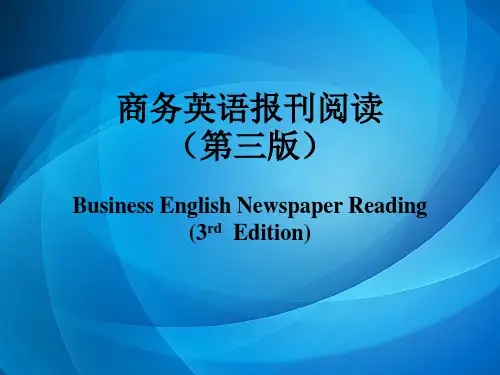
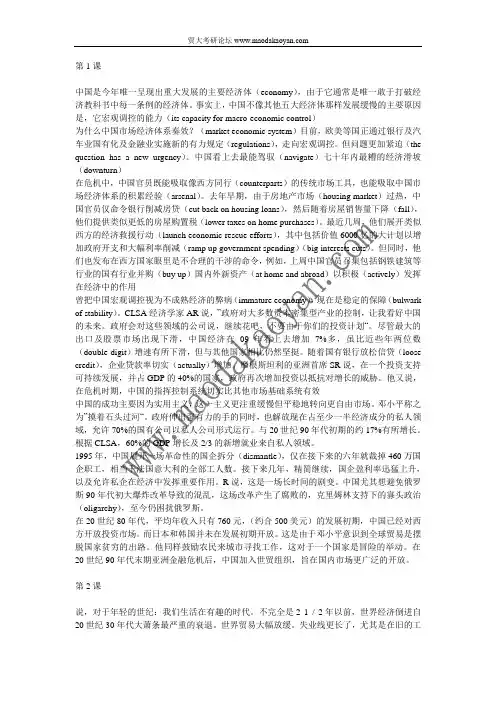
第1课中国是今年唯一呈现出重大发展的主要经济体(economy),由于它通常是唯一敢于打破经济教科书中每一条例的经济体。
事实上,中国不像其他五大经济体那样发展缓慢的主要原因是,它宏观调控的能力(its capacity for macro-economic control)为什么中国市场经济体系奏效?(market economic system)目前,欧美等国正通过银行及汽车业国有化及金融业实施新的有力规定(regulations),走向宏观调控。
但问题更加紧迫(the question has a new urgency)。
中国看上去最能驾驭(navigate)七十年内最糟的经济滑坡(downturn)在危机中,中国官员既能吸取像西方同行(counterparts)的传统市场工具,也能吸取中国市场经济体系的积累经验(arsenal)。
去年早期,由于房地产市场(housing market)过热,中国官员仅命令银行削减房贷(cut back on housing loans),然后随着房屋销售量下降(fall),他们提供类似更低的房屋购置税(lower taxes on home purchases)。
最近几周,他们展开类似西方的经济救援行动(launch economic rescue efforts),其中包括价值6000亿的大计划以增加政府开支和大幅利率削减(ramp up government spending)(big interests cuts)。
但同时,他们也发布在西方国家眼里是不合理的干涉的命令,例如,上周中国官员召集包括钢铁建筑等行业的国有行业并购(buy up)国内外新资产(at home and abroad)以积极(actively)发挥在经济中的作用曾把中国宏观调控视为不成熟经济的弊病(immature economy),现在是稳定的保障(bulwark of stability)。
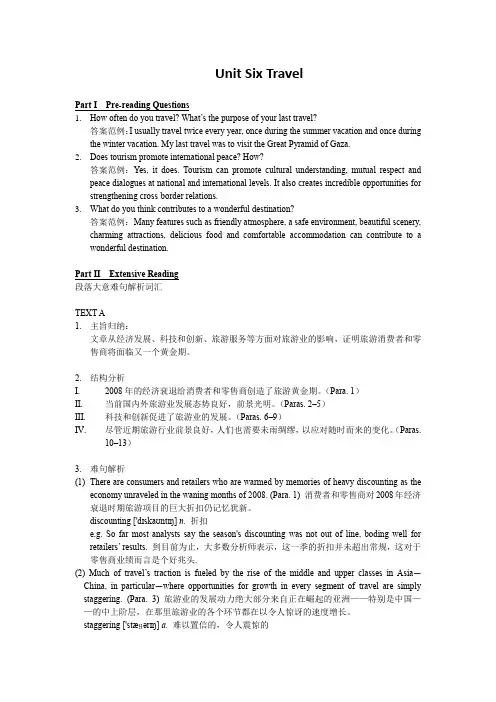
Unit Six TravelPart I Pre-reading Questions1.How often do you travel? What’s the purpose of your last travel?答案范例:I usually travel twice every year, once during the summer vacation and once during the winter vacation. My last travel was to visit the Great Pyramid of Gaza.2.Does tourism promote international peace? How?答案范例:Yes, it does. Tourism can promote cultural understanding, mutual respect and peace dialogues at national and international levels.It also creates incredible opportunities for strengthening cross-border relations.3.What do you think contributes to a wonderful destination?答案范例:Many features such as friendly atmosphere, a safe environment, beautiful scenery, charming attractions, delicious food and comfortable accommodation can contribute to a wonderful destination.Part II Extensive Reading段落大意难句解析词汇TEXT A1.主旨归纳:文章从经济发展、科技和创新、旅游服务等方面对旅游业的影响,证明旅游消费者和零售商将面临又一个黄金期。
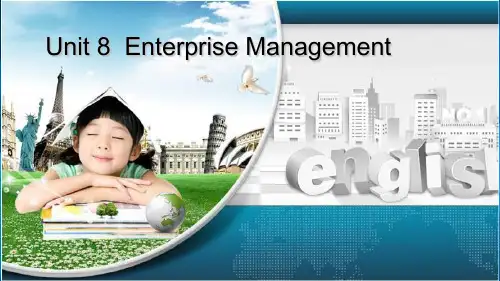

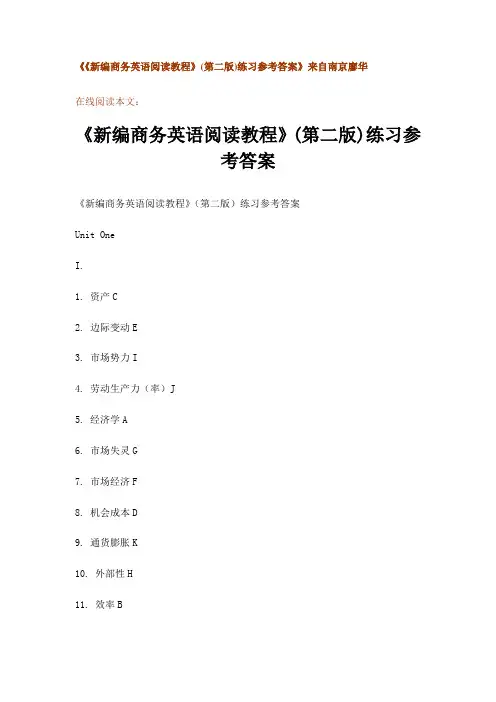
《《新编商务英语阅读教程》(第二版)练习参考答案》来自南京廖华在线阅读本文:《新编商务英语阅读教程》(第二版)练习参考答案《新编商务英语阅读教程》(第二版)练习参考答案Unit OneI.1. 资产C2. 边际变动E3. 市场势力I4. 劳动生产力(率)J5. 经济学A6. 市场失灵G7. 市场经济F8. 机会成本D9. 通货膨胀K10. 外部性H11. 效率B12. 菲利普斯曲线LII.Passage One经济学的研究主要分为两部分:宏观经济学与微观经济学。
宏观经济学着眼于经济全局——一幅宏观的画面。
在宏观经济学中,我们研究国家的政策目标,例如充分就业、抑制通货膨胀、经济增长等,而不考虑个人或者单个团体的利益和行为。
对宏观经济学的关注是为了从总体上认识并改善经济的运行。
微观经济学则关注宏观画面中的细节。
在微观经济学中,我们着眼于实际构成宏观经济的个人、厂商和政府机构。
我们感兴趣的是这些独立经济单位的行为。
他们的目标何在?以有限资源实现目标的途径是什么?如何对各种激励和机会做出反应?宏观经济学主要关注,例如,总消费性支出对总产出、就业及物价的影响。
很少关注消费性支出及其决定因素的实际内涵。
相反,微观经济学关注的是个体消费者具体的支出决策及其影响因素(爱好、物价水平、收入状况)。
宏、微观经济学的区别还反映在关于企业投资的讨论中。
宏观经济学中,我们需要了解决定企业总投资率的因素以及这些投资对一国的总产出、就业及物价水平产生影响的路径。
而微观经济学中,我们关注的是各家企业关于生产率、生产要素的抉择以及具体物品的定价决策。
了解宏、微观经济学的区别并非难事。
在现实社会,宏观经济的表现有赖于微观行为,而微观行为又受宏观经济表现的影响。
因此,人们只有了解了所有经济活动的参与者的行为方式及其成因,才能充分了解整个经济的运作方式。
但是,就如你会开车而不懂发动机的构造原理那样,你能观察到经济运行方式但并不能完全解开其中奥秘。
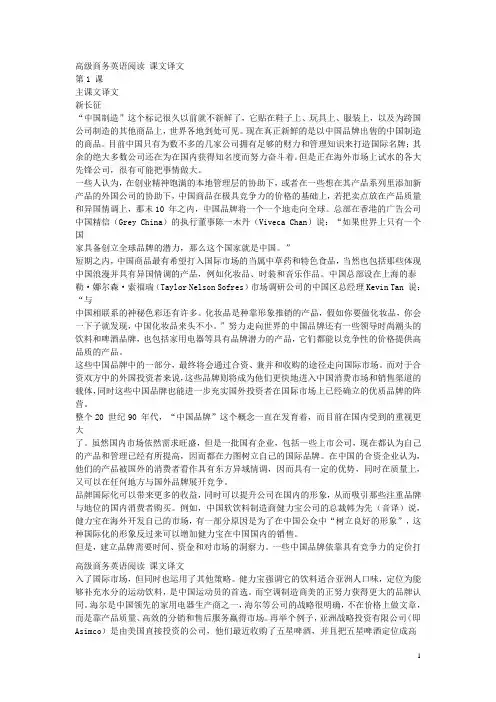
高级商务英语阅读课文译文第1 课主课文译文新长征“中国制造”这个标记很久以前就不新鲜了,它贴在鞋子上、玩具上、服装上,以及为跨国公司制造的其他商品上,世界各地到处可见。
现在真正新鲜的是以中国品牌出售的中国制造的商品。
目前中国只有为数不多的几家公司拥有足够的财力和管理知识来打造国际名牌;其余的绝大多数公司还在为在国内获得知名度而努力奋斗着。
但是正在海外市场上试水的各大先锋公司,很有可能把事情做大。
一些人认为,在创业精神饱满的本地管理层的协助下,或者在一些想在其产品系列里添加新产品的外国公司的协助下,中国商品在极具竞争力的价格的基础上,若把卖点放在产品质量和异国情调上,那末10 年之内,中国品牌将一个一个地走向全球。
总部在香港的广告公司中国精信(Grey China)的执行董事陈一木丹(Viveca Chan)说:“如果世界上只有一个国家具备创立全球品牌的潜力,那么这个国家就是中国。
”短期之内,中国商品最有希望打入国际市场的当属中草药和特色食品,当然也包括那些体现中国浪漫并具有异国情调的产品,例如化妆品、时装和音乐作品。
中国总部设在上海的泰勒·娜尔森·索福瑞(Taylor Nelson Sofres)市场调研公司的中国区总经理Kevin Tan 说:“与中国相联系的神秘色彩还有许多。
化妆品是种靠形象推销的产品,假如你要做化妆品,你会一下子就发现,中国化妆品来头不小。
”努力走向世界的中国品牌还有一些领导时尚潮头的饮料和啤酒品牌,也包括家用电器等具有品牌潜力的产品,它们都能以竞争性的价格提供高品质的产品。
这些中国品牌中的一部分,最终将会通过合资、兼并和收购的途径走向国际市场。
而对于合资双方中的外国投资者来说,这些品牌则将成为他们更快地进入中国消费市场和销售渠道的载体,同时这些中国品牌也能进一步充实国外投资者在国际市场上已经确立的优质品牌的阵营。
整个20 世纪90 年代,“中国品牌”这个概念一直在发育着,而目前在国内受到的重视更大了。
W
ithout a doubt, technology has significantly turned the world into an online village. With just one click of a button, it is possible to shop for anything online and have it deliv-ered to your doorstep.
2 While goods still need to be moved the same distance to reach a consumer, the logistics industry can benefit from adopt ing new-age logistics technology. From late to missed deliveries and even dam-aged goods on transit, numerous problems in the logistics industry continue to affect the delivery of goods negatively.
With technology, it is possible to 物扫码听读
就能确定哪些流程需要自动化。
客户消费欲望的变化
产品和服务的需求每天都在变化,大公司愿意花大价钱获取相关数据。
可靠的产品推荐改变客户的消费欲望,而消费欲望的变化影响所需产品的类型以及订单数量。
掌握这些信息,企业就能减少浪费和滞销。
消费者需求变化迅速,几乎无法预料消费模式的变化。
分析技术可使企业更加轻。
商务英语阅读答案Unit 1Why China WorksExercises1. Answer the questions on the text:1) How does the author view the Chinese economy?It is the most important bright spot in the world economy under the global recession, the only major economy that is likely to show significant growth this year, and the only one that routinely breaks every rule in the economic textbook.2) According to the author, why can the Chinese economy perform so well? Because of:(1) the capacity for state control by the Chinese government.(2) its rejection of exotic financial innovations that are the melting core of theglobal credit crisis.(3) the integration of its economic policies between traditional market tools andstate control measures.3) In what way does the author imply that western economists are erroneous in their bias toward “China’s market economic system”?The United States and Europe are moving toward state control by nationalizing their banking and car industries, and imposing heavy new regulation on the financial industry.4) What is the view of Stephen Roach on the Chinese economy system?Investment is the backbone of sustainable growth in the Chinese economy, which works more effectively than othermarket based systems in times of economic stress.5) Why can China work in the eye of the author?It has followed a radical pragmatism focusing on a slow but steady shift toward freer markets.6) What is regarded as the strategic thinking of the Chinese leaders in market reforms?They understand even under the serious financial crisis that it can stabilize the Chinese market and economy to introduce more sophisticated forms of securitization, including stock index funds, corporate bonds and other debt products. They also realize that, in the course of doing this, they should learn from the mistakes the westerners have made.7) What is the example given to illustrate the steadiness of the Chinese leaders in their policy execution?They continue to allow the value of yuan to rise despite of the American charges and the need for export competitiveness by their own enterprises.8) What is “shock therapy”?It is the economic policy adopted in Russia from 1991 to 1992 that totally deregulated prices and lead to a runaway inflation. It proved to be all shock and notherapy.9) In what ways does the Chinese economic system work efficiently?It can get things done quickly, move in a coherent manner, and marshal its people and resources to a common target: economic growth and prosperity.11) What are the Internet and public opinion used for?For putting pressure on local officials and influencing policy decisions.2. Fill in each blank of the following sentences with one of the phrases in the list given below. Make changes when necessary.1)At a time when the need is growing for mental health services, many countriesare unfortunately cutting back on its spending.2)There is an increasing number of people out of work. But the western media oftenunfairly label them as lazy and reliable.3)Now that the flow of oil has been stopped by BP, the impact of all the spilled oiland natural gas is still being measured.4)Once again its ability to steer economic policy will be tested against the ability todeliver on services and projects aimed at growing the economy and jobs.5)Housing prices are incredibly high today. But he bought his house for a songabout five years ago.6)As people are complaining high prices, especially those related to dailynecessities, the government feels rather urgent to hold down inflation rate immediately.7)Under the new economy policy investors are invited to buy into state-ownedenterprises.8)Since a serious gun shooting occurred in Arizona last week, security concernshave trickled down to all places, including residential buildings.9)Social unrest is a daily occurrence in the country nowadays.It is in the last placewhen it comes to investment for multinational companies.10)Efforts to ban smoking in China are so effective yet. Some chain smokers neverthink of quitting while many others have battled in vain to quit.3. Match the terms in column A with the definitions in column B:A_______________________ B__________________________________1)financial innovation A) A reduction in the general availability of loans (orcredit) or a sudden tightening of the conditionsrequired to obtain a loan from the banks.72)stimulus package B) A non-bank entity or organization such asinvestment companies and mutual funds thatinvests in large quantities. 83)overheating C)A legal entity created by a government to undertakecommercial activities on its behalf. 64)stamp tax D) The trading of a corporation's stock or othersecurities (e.g. bonds or stock options) byindividuals with potential access to non-publicinformation.9E) An industry that requires large amounts of capital,machinery and equipment to produce goods. 55)capital-intensive sector F) Generation of new and creative approaches tosecurities, money management or investing. 16)state-run firm G) An economy that is expanding so rapidlythat toomuch money is chasing too few goods andeconomists fear a rise in inflation . 37)credit crisis H) tax levied on certain legal transactions such as thetransfer of a property such as building, copyright,land, patent, and securities. 48)institutional investor I) A plan or a series of measures taken by agovernment to jump-start its ailing economy,generally as a part of its fiscal policy. 210) insider trading4. Translate the following passage into Chinese.我们所面临的来自中国的真正挑战并不是他们向我们大量销售的货物,而恰恰相反,是他们正在提升的价值链。
Part Two:Passage ReadingTask 11. “C opycat” electronic products and cheap wedding dresses.2. Through intelligent recommendation technology and intangible interactions.3. They expect that a product bought on Cdiscount arrives at a speed comparable to ordinary French products.Task 21.accessory2. consensus3. accrueattribute4. repulsive5. In view of6. warranty7. dedicate8. concedeTask 31.Such shirts packed in carton box can save freight cost.2.Each newbie had to go to the front and made a brief self- introduction.3.Please quote us as soon as you receive our inquiry.4.Are you satisfied with the performance of your new car?5.The reconstruction of the city is underway.6.John attributed his success to good luck.Passage Translation各国电子商务网络平台的现状无论是国内还是国外的企业家都逐渐意识到电子商务中所蕴含的巨大商机,不少企业开始由单一的线下传统交易模式向互联网电子商务交易模式转移。
中国物流企业面临的挑战“十五”期间中国的物流业快速增长。
根据中国发改委、中国统计局、中国采购与物流协会的统计,“十五”期间社会物流总值达到了158.7万亿元人民币,与“九五”同期相比增长了1.4倍,达到了平均23%的年增长率,远远高于9.5%的国内生产总值的增长率。
物流总额在国内生产总值中所占的比重从2000年的19.4%下降到2005年的18.6%。
2005年中国物流总值超过了1.2万亿元人民币,年增长率为12.7%,占服务业附加值的16.6%。
近年来中国的物流市场对外开放。
显然国营、私营和外资企业同在一个竞争的市场上生存和发展。
根据加入世界贸易组织(WTO)时的承诺,中国将在2005年12月11日全面开放物流市场。
2006年是中国“十一五”计划的第一年,也是物流市场完全开放的第一年。
毫无疑问,随着经济的发展和中国制造业和零售业大量接受物流服务外包,中国的物流业开始快速增长的阶段。
然而中国的物流企业仍旧面临着一系列的问题,包括经济特区以外较差的运输、信息和交通设施,官僚和行政的作风,能源供给的诸多问题,物流和运输的高成本,从业人员受教育程度低而且培训极差,以及国内和国际贸易地区的不平衡。
而且中国的经济正在经历一个许多国营企业向私营企业转变的结构重组期。
一个很重要的问题是高速的经济增长导致了劳动力成本的提高特别是在制造业和物流业。
这就给效率低下的公有部门增加了压力,从而最终导致高失业率。
这些问题由于按照中国加入世界贸易组织(WTO)的承诺,允许外国竞争者的进入市场而加剧。
知情人士提到,“如果中国的经济发展真像很多经济学家预言的那样‘硬着陆’,那么将对这一地区物流业过度投资的空运、海运和物流快递行业产生巨大的影响。
尽管目前中国运输市场不完善和附加值低,但它仍然会为国内外较强的物流企业提供巨大的机会。
”经济的不平衡中国的经济活动和发展水平有很大的差异。
货物的流动从发达的东部地区到欠发达的西部地区有很大的不平衡。